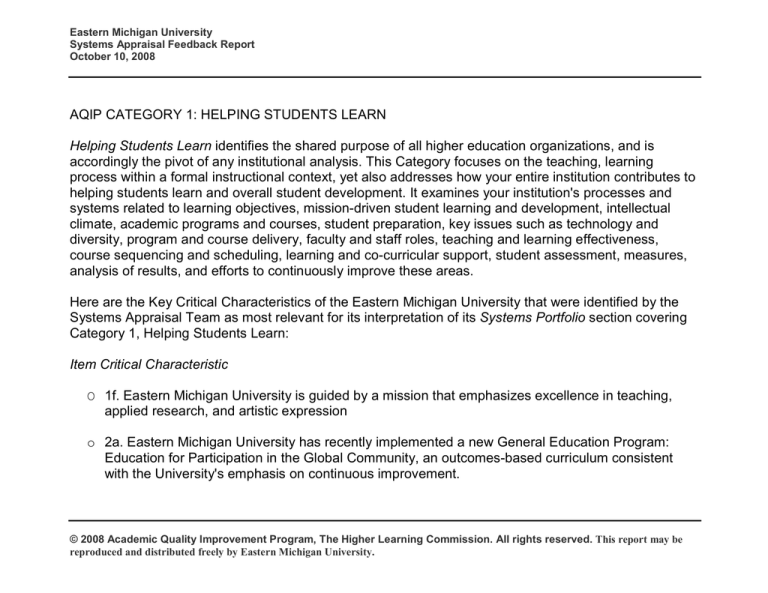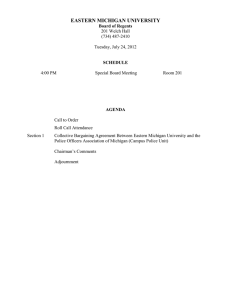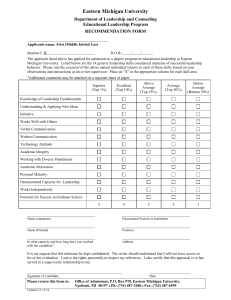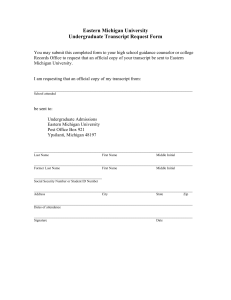
Eastern Michigan University Systems Appraisal Feedback Report October 10, 2008 AQIP CATEGORY 1: HELPING STUDENTS LEARN Helping Students Learn identifies the shared purpose of all higher education organizations, and is accordingly the pivot of any institutional analysis. This Category focuses on the teaching, learning process within a formal instructional context, yet also addresses how your entire institution contributes to helping students learn and overall student development. It examines your institution's processes and systems related to learning objectives, mission­driven student learning and development, intellectual climate, academic programs and courses, student preparation, key issues such as technology and diversity, program and course delivery, faculty and staff roles, teaching and learning effectiveness, course sequencing and scheduling, learning and co­curricular support, student assessment, measures, analysis of results, and efforts to continuously improve these areas. Here are the Key Critical Characteristics of the Eastern Michigan University that were identified by the Systems Appraisal Team as most relevant for its interpretation of its Systems Portfolio section covering Category 1, Helping Students Learn: Item Critical Characteristic O 1f. Eastern Michigan University is guided by a mission that emphasizes excellence in teaching, applied research, and artistic expression o 2a. Eastern Michigan University has recently implemented a new General Education Program: Education for Participation in the Global Community, an outcomes­based curriculum consistent with the University's emphasis on continuous improvement.
© 2008 Academic Quality Improvement Program, The Higher Learning Commission. All rights reserved. This report may be reproduced and distributed freely by Eastern Michigan University. Eastern Michigan University Systems Appraisal Feedback Report October 10, 2008 o 2b. Students have an opportunity to take classes and complete programs at seven off campus locations through Continuing Education o 2c. Eastern Michigan University consists of a graduate school and five colleges: Arts and Sciences; Business; Education; Health and Human Services; and Technology. In addition, the Honor's College provides enhanced interdisciplinary programs to approximately 1000 students. o 2d. Eastern Michigan University's new General Education program includes a Learning Beyond the Classroom component in which students are required to participate in extracurricular and co­ curricular activities. o 6d. Since 2005, technological investment and improvement includes 41 computer labs, 16 computer classrooms, and wireless networking to 42 buildings. Here are what the Systems Appraisal Team identified as Eastern Michigan University’s most important strengths and opportunities for improvement relating to processes encompassed by Category 1, Helping Students Learn. Item S/O 1P1 S Comment Program learning outcomes are developed by faculty in conjunction with the mission statement and informed by employers, accrediting bodies and other stakeholders. General Education outcomes reflect the mission and strategic goals, as developed and approved by faculty through the General Education Program Advisory Committee, although the exact process by which the outcomes were developed is not identified.
© 2008 Academic Quality Improvement Program, The Higher Learning Commission. All rights reserved. This report may be reproduced and distributed freely by Eastern Michigan University. Eastern Michigan University Systems Appraisal Feedback Report October 10, 2008 Common learning objectives are published on the website, in course syllabi, and catalogues. These common learning objectives will help Eastern Michigan University to achieve the excellent teaching and a student­focused learning environment aspect of its mission. 1P2 S Eastern Michigan University has established and published its Course and Program Development Process, which includes input and review by faculty committees and senior administration. New programs are developed in conjunction with both student and market needs. 1P3 S Preparation requirements for students for courses and programs are identified by faculty at the departmental level and, where appropriate, with accrediting bodies. 1P4 O A range of different methods is used to communicate expectations to students regarding learning objectives for courses and programs, although Eastern Michigan University acknowledges weaknesses in this process. A current AQIP Action Project is aimed at enhancing the advising process and addressing weaknesses in processes for communicating expectations to students. 1P5 O Eastern Michigan University has identified some processes by which new students are advised in the selection of courses, including a new Fast Track program for advising, placement testing and registration support, and the use of self­guided materials to place students in appropriate first year composition courses. However, processes are not identified to assist students in the selection of appropriate programs of study or to address the lack of preparation for students prior to, or after, selecting particular programs. While progress is being made through the new Fast Track program, it is
© 2008 Academic Quality Improvement Program, The Higher Learning Commission. All rights reserved. This report may be reproduced and distributed freely by Eastern Michigan University. Eastern Michigan University Systems Appraisal Feedback Report October 10, 2008 important to ensure that methods for addressing discrepancies in preparation are in place for all programs. 1P6 S Processes for determining and documenting effective teaching are incorporated into the faculty evaluation process for tenure and promotion, and these are incorporated into bargaining agreements for faculty and lecturers. Faculty submit various documents and teaching materials for the evaluation which are reviewed by personnel committees and department heads. While direct measures of student learning do not appear to be included, these processes provide some useful information for documenting the instructional practices of faculty. 1P7 O At this point, methods for developing effective and efficient course delivery is decentralized, with decisions made by individual faculty members. The University can benefit by a more institutional approach, aligned with its strategic goals, to insure an effective balance of student, faculty and institutional needs. 1P8 S Processes for monitoring the currency and effectiveness of the curriculum include appropriate faculty bodies, the Office of Academic Programming, College Councils, and the Provost’s Office. Eastern Michigan University is piloting a new Integrated Program Review and Continuous Improvement Cycle process, which aligns long­term institutional goals with strategic, short­term objectives, which are tied to the University’s annual plan. Coupled with input from disciplinary faculty, this process has the potential to foster a more uniform method for addressing currency in programs.
© 2008 Academic Quality Improvement Program, The Higher Learning Commission. All rights reserved. This report may be reproduced and distributed freely by Eastern Michigan University. Eastern Michigan University Systems Appraisal Feedback Report October 10, 2008 1P9 O Methods for determining student and faculty needs relative to learning support are incorporated into various areas focused on learning support, but it is not clear if these are adequate to elicit sufficient information. Various surveys are conducted across the University, but may be too broad and general to provide adequate information on student learning needs. As noted, current methods are acknowledged to need further development and these can enhance the University’s efforts in this essential area. 1P10 O Eastern Michigan University is in the developmental stages of incorporating co­ curricular goals into its new General Education requirement involving earning Beyond the Classroom. This will be an important step forward, given the scope of its impact on the Gen Ed curriculum. Meanwhile, other co­curricular activities remain unevenly aligned with curricular learning objectives. The University could benefit from a more comprehensive effort to review curricular and co­curricular alignment. 1P11 O Eastern Michigan University is in the developmental stages of determining processes for assessment of student learning. Procedures for the new General Education curriculum are being developed as part of an AQIP Action Project and show progress. Program ­level assessment is decentralized and under the aegis of departments, although reporting to the Assessment Office is also part of the process. Rubrics have been developed and student work is evaluated by raters from different disciplines. Given the range of assessment methods across the departments and disciplines, the University may find value in a review of assessment processes at the program level, along with its General Education assessment program, to insure valid and effective assessment measures.
© 2008 Academic Quality Improvement Program, The Higher Learning Commission. All rights reserved. This report may be reproduced and distributed freely by Eastern Michigan University. Eastern Michigan University Systems Appraisal Feedback Report October 10, 2008 1P12 O No uniform mechanism is in place to assess student preparation for further study or employment. Procedures for the summative assessment of program graduates vary across departments and are more fully developed in programs where accrediting bodies specify these methods. The University will benefit, as noted, from increased sharing and communication across departments to allow for development of more effective program learning assessment. 1P13 O While the University employs various methods for measuring student performance, most metrics address indirect measures of learning (e.g. enrollment and persistence or student self­evaluation) or non­standard measures (such as student course grades and, possibly, varying methods from program assessment). New direct measures are being developed for the General Education curriculum. More systematic procedures for review of programs, which are just beginning, can provide a valuable source of information in this area. An AQIP Action Project focusing on these issues is underway. 1R1 O At this stage, the University has developed and adopted a new General Education program with defined outcomes and linkages to curriculum. Several procedures are under development or are generating initial results on student learning from selected areas and programs. However, only limited and cursory results for student learning achievement are available, even from programs that require documentation of student learning and effective instruction for certification and licensure. The first review of program assessment will be an important milestone in the process. As results begin to emerge, Eastern Michigan University will have the opportunity to identify areas for improvement or to celebrate existing success.
© 2008 Academic Quality Improvement Program, The Higher Learning Commission. All rights reserved. This report may be reproduced and distributed freely by Eastern Michigan University. Eastern Michigan University Systems Appraisal Feedback Report October 10, 2008 1R2 O Results of summative learning achievement are largely available only for programs where licensure or certification exams are used. Other measures suggest perceived effective quality of education, but these are derived from student satisfaction surveys, rather than direct measures of learning. The University currently has limited results addressing students’ acquired knowledge and skills relevant to employers and other institutions. 1R3 O Eastern Michigan University generates very limited results of its efforts to improve teaching and learning support. Results are primarily measures of usage of support services by students. A more direct focus on determining the effectiveness of these efforts could provide valuable information. 1R4 OO Eastern Michigan University has no comparative results to report. The use of select institutional metrics benchmarked against Eastern Michigan University’s peer group(s) will provide opportunities for identification of appropriate areas of improvement. 1l1, 1l2 OO Improvement based on results from existing measures are not yet available.
© 2008 Academic Quality Improvement Program, The Higher Learning Commission. All rights reserved. This report may be reproduced and distributed freely by Eastern Michigan University.



